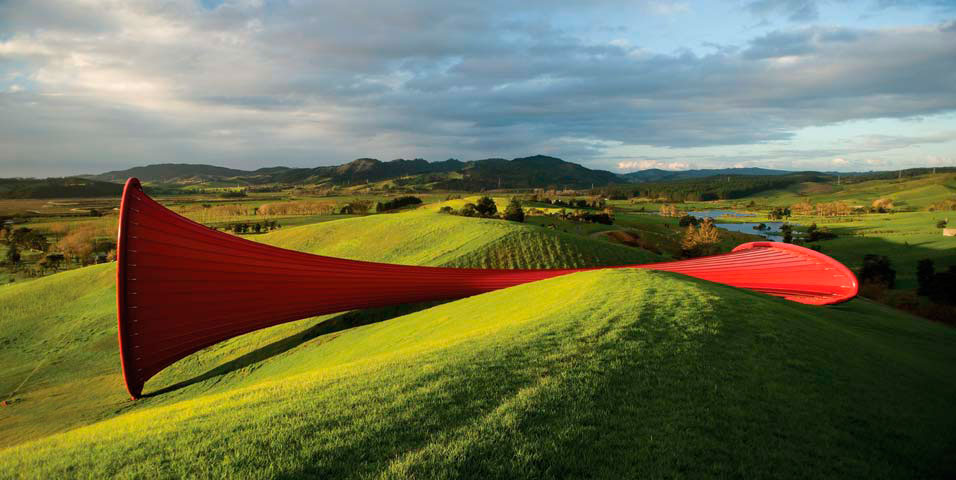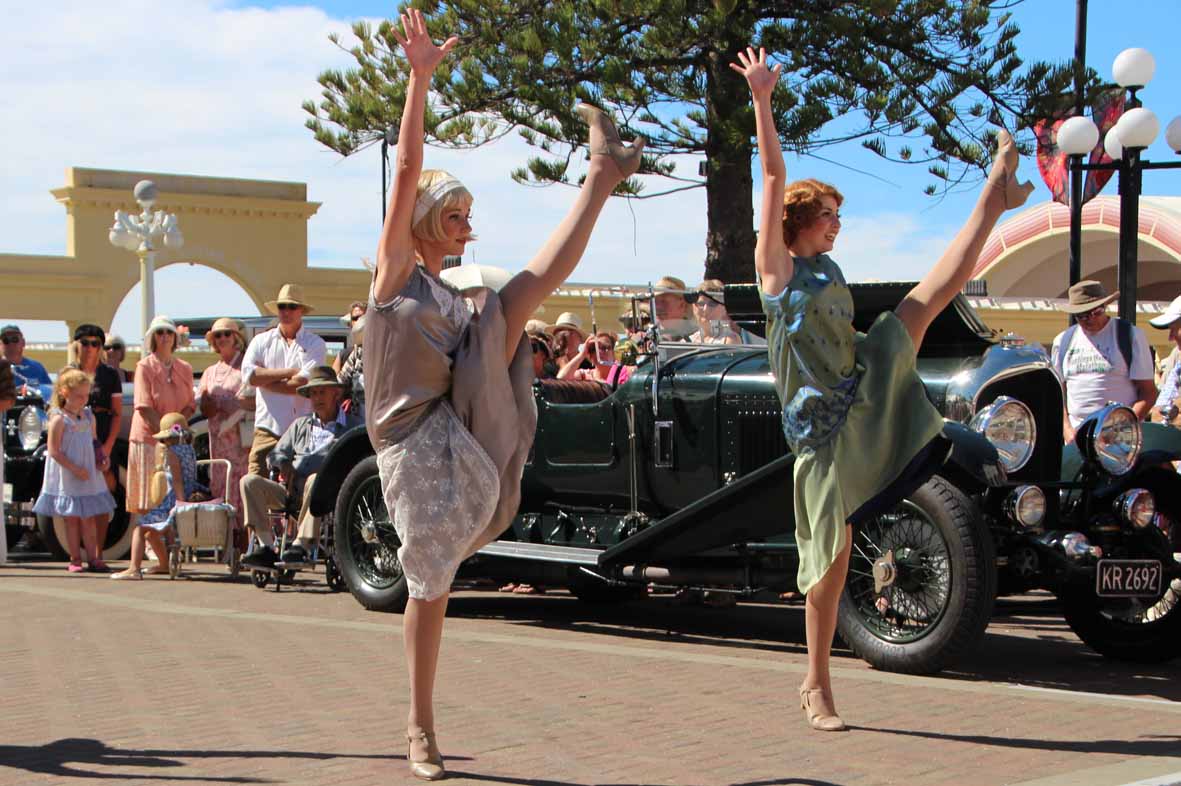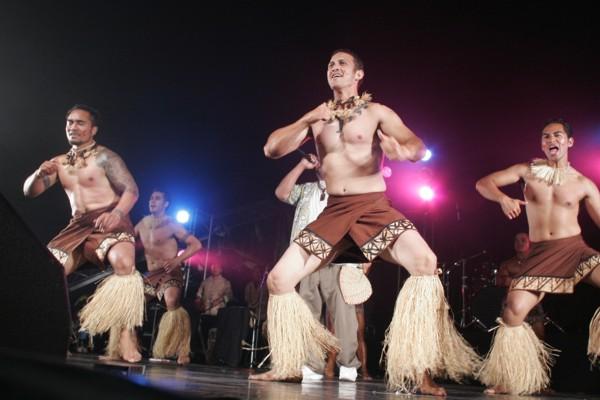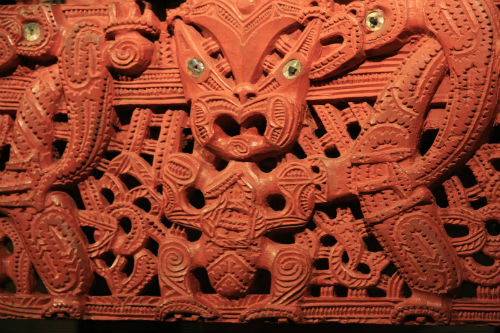Wearable art by John and Jenny Gillies Photo: kapcha.co.nz
It has been difficult for New Zealand to sell sophistication without undermining its key marketing campaign, the ‘100% Pure New Zealand’ brand built on the sense of an untouched wilderness.
But within the small country there is space for both natural beauty and city culture. New Zealand is drawing cultural tourists south, showing potential visitors that there is more to the country than pristine lakes and luxuriant bushland.
The new feel is evident as soon as you board an Air New Zealand flight. From the tempting cinematography of sophisticated cities in the destination videos to the funky new look uniforms with their reinterpretation of the koru motif by NZ fashion designer Trelise Cooper, culture is already jostling natural beauty aside for a prime position.
In Australia, there is an acknowledgement that NZ, for so long the smaller sibling, is worth a serious look. Art Month in Sydney is offering a panel called Great Southern Lands: Australian and New Zealand art in opposition and parallel which will consider the cultural distinctiveness of the two countries.
Key cultural destinations are festivals and events but there are also institutions and tours catering for cultural tourists. Here are some highlights.
1. Gibbs Farm

Anish Kapoor, Dismemberment, Site 1, Photo: Gibbs Farm
Australian sculptor Ron Robertson-Swann thinks Gibbs Farm may be the most important outdoor sculpture destination in the world, even more impressive than its northern hemisphere equivalent, Storm King in New York State. The North Auckland property is a private venture only open by appointment or through a Sculpture-by-the-Sea Sculpture, Food and Wine tour. Most of the work is commissioned to fit the vast landscape of rolling hills and water, enabling impressive scale. The farm contains the largest Anish Kapoor in the world, cut into the side of a hill, and a 252 m snaking Richard Serra tracing a contour line across the landscape. Other important works are by Graham Bennett, Chris Booth, Daniel Buren, Bill Culbert, Neil Dawson, Marijke de Goey, Andy Goldsworthy, Ralph Hotere, Sol LeWitt, Len Lye, Russell Moses, Peter Nicholls, Eric Orr, Tony Oursler, George Rickey, Peter Roche, Kenneth Snelson, Richard Thompson, Leon van den Eijkel and Zhan Wang.2. Art Deco weekend

Art Deco street life Photo: Deborah Stone
The rebuilding of the city of Napier after the massive 1931 earthquake delivered the city with the world’s fullest example of Art Deco architecture and over the past 26 years the city has learned to make the most of it. There are Art Deco architecture tours all year round and simply wandering the streets and strolling into shops gives plenty of opportunity to discover the soaring domes, lavish decoration and distinctive motifs of the 1920s and 1930s. But the small city comes alive on the annual Art Deco Weekend in February with jazz music, a vintage car parade, Charleston dance lessons, a Gatsby picnic and dozens of other Deco-style events. Be warned: Art Deco Weekend is not a spectator activity but the town is packed with vintage outfitters like Charleston Chic so there are plenty of places to choose your cloche and beaded dress or bow tie and boater to become a part of the fun.
3. Food and wine

Hawkes Bay wineries Photo:Deborah Stone
A foodie culture that draws on New Zealand’s natural agricultural advantages is delivering top restaurants, high quality ingredients and fine wines. The region of Hawkes Bay has registered 800 hectares of distinctive draining soil called the Gimblett Gravels which producers at vineyards such as Trinity Hill hope will rival Bordeaux in rich, definable reds. The region also boasts the country’s first Farmers’ Market (now imitated in many places) where you can purchase such unique products as smoked terakihi fish, fejoa relish and local kiwifruit jam. At the magnificent Craggy Range winery we tasted bread made from kumara (New Zealand sweet potato) delivering the consistency of sourdough but with a much sweeter taste, and at Elephant Hill winery the finest smoked venison. Waiheke Island, off the coast of Auckland, also boasts a significant wine and food culture well worth a pilgrimage.
5. World of Wearable Art (WOW)
When high-profile actor and personality Stephen Fry attended WOW he described it as ‘one of the great evenings of my life’. WOW is a two hour show held annually in September in Wellington to an audience of 50,000 over a 12 show season. The show crosses the boundary from fashion to theatre, treating the human body as a canvas for a display of theatrical costume that has drawn an international following. For designers, the event is a prestigious competition and for audiences it is great spectacle. Last year’s grand winner was a set of two garments called ‘The Exchange’ made of ceramic feathers and coins and offering a political commentary on cultural assimilation and the Treaty of Waitangi, the founding agreement between the Indigenous Maori and the colonising British.
5. Middle Earth


Air New Zealand capitalising on Hobbit fever Photo: Air New Zealand
As soon as you step onto your Air New Zealand flight it is clear the country is making the most of the windfall that came with the filming of The Lord of the Rings and, more recently, The Hobbit in New Zealand. The standard safety video is replaced with a creative version featuring Frodo tightening his seat belt and Gandolf extinguishing his long pipe. If you are lucky you may even get to fly on Air New Zealand’s Lord of the Rings or Hobbit aircraft. Once on the ground Elvish enthusiasts can take Lord of the Rings tours to destinations featured in the films including Edoras, the Vale of Wizards and the Middle Earth trail (better known to the locals as Mt Sunday, Glenorchy and the Great Southern Lakes respectively). There are more than 150 dramatic destinations from the films to visit as well as the movie set, recast as Hobbiton.
6. Pasifika

New Zealand has both an Indigenous Polynesian community, the Maori, and a significant Pacific Island population and the annual Pasifika Festival in Auckland each March celebrates the range and richness of the Pacific Island cultures. The festival is a local community event that hosts more than 300 stallholders and performances from the Cook Islands, Fiji, Kiribati, Niue, Samoa, Tahiti, Tonga, Tokelau, Tuvalu, Hawaii & Aotearoa (the last being the Maori name for New Zealand). In addition to performance and display the event has more than 100 craft stalls so there are opportunities to pick up a traditional carvings, jewellery and weaving – or even get a traditional tattoo.
7. NZ International Arts Festival

Power Plant, a display of kinetic sculptures Photo: NZ International Arts Festival
Unless you can scoot across the Tasman in the next couple of weeks, you have missed this year’s NZ International Arts Festival but the Biennial Festival is fast becoming an event worth putting in your diary for future years. This year’s festival runs across 24 days to March 16 and includes spectacular, theatre, dance, music, visual arts, film and a writers’ week. There are a substantial number of events already seen at major Australian festivals, like the Batsheva Dance Company, or coming from Australia, like Circa, but the Festival is starting to draw major international talent on its own merit as well showcasing local product. By Australian standards it is a relatively small and manageable arts festival and a great place to discover NZ’s increasing sophistication.
8. Taonga Maori

Maori carving Photo: Auckland War Memorial Museum
Both the much older Auckland War Memorial Museum and the more modern Museum of New Zealand have a strong emphasis on Maori culture with magnificent displays of Taonga Maori (Maori treasures). The Auckland display includes a number of original full-size buildings, among them a meeting house you can enter. Even more impressive is Te Toki ā Tāpiri, a 25 metre great war canoe carved from a giant totara tree. Both museums have significant collections of small objects such as ancestral carvings, personal ornaments, garments, and weaponry and have guided tours and sometimes performances of Maori culture.
Deborah Stone attended the Art Deco Weekend courtesy of Air New Zealand, Art Deco Trust and Hawke’s Bay Tourism rather than New Zealand Tourism. Air New Zealand has daily connections from Australia to Napier connecting via Auckland or Wellington, visit airnewzealand.com.au for more info.





